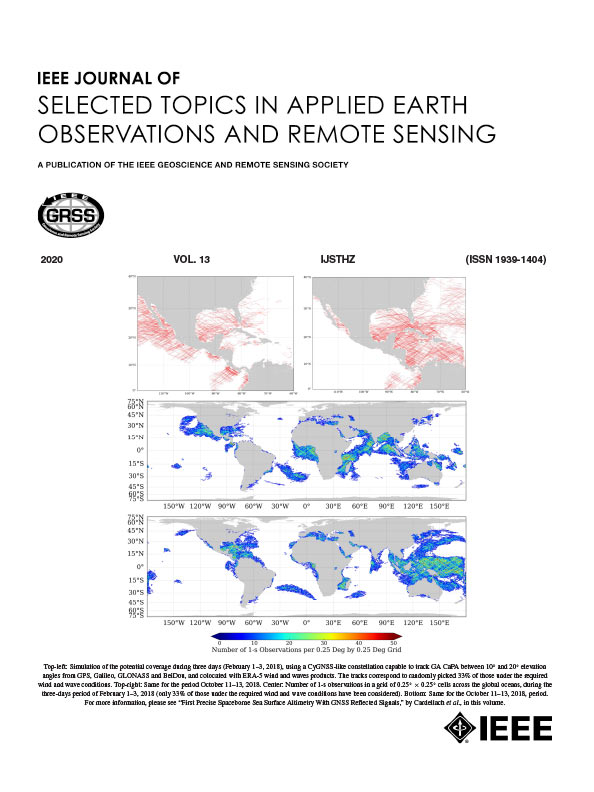基于深度融合多尺度特征的高分辨率遥感影像道路提取并行双分支模型
IF 4.7
2区 地球科学
Q1 ENGINEERING, ELECTRICAL & ELECTRONIC
IEEE Journal of Selected Topics in Applied Earth Observations and Remote Sensing
Pub Date : 2025-03-28
DOI:10.1109/JSTARS.2025.3555636
引用次数: 0
摘要
现有的编码器-解码器模型,或带有无序卷积的编码器-解码器模型,在高分辨率遥感图像中的道路尺度、阴影、建筑物遮挡和植被等不同环境下暴露出其局限性。因此,本文介绍了一种名为 "DeepU-Net "的双分支深度融合网络,用于并行获取全局和局部信息。本文设计了两个新颖的模块:1)空间和坐标挤压激励融合关注模块,可加强对空间位置和目标通道信息的关注;2)高效的多尺度卷积关注模块,可提高处理多尺度道路信息的能力。利用 CHN6-CUG 和 DeepGlobe 这两个分别来自城市和农村地区的数据集对所提出的模型进行了验证。并与 U-Net、PSPNet、DeepLabv3+、HRNet、CoANet 和 SegFormer 等六种常用模型进行了对比分析。实验结果表明,与六种常用模型相比,引入的模型在两个数据集上实现了平均 83.18% 和 81.43% 的联合交叉得分,平均分别提高了 1.93% 和 1.02%。这些结果表明,引入的模型比六种广泛应用的模型获得了更高的精确度。本文章由计算机程序翻译,如有差异,请以英文原文为准。
DeepU-Net: A Parallel Dual-Branch Model for Deeply Fusing Multiscale Features for Road Extraction From High-Resolution Remote Sensing Images
The existing encoder–decoder model, or encoder–decoder model with atrous convolutions, has exposed its limitations under diverse environments, such as road scales, shadows, building occlusions, and vegetation in high-resolution remote sensing images. Therefore, this article introduces a dual-branch deep fusion network, named “DeepU-Net,” for obtaining global and local information in parallel. Two novel modules are designed: 1) the spatial and coordinate squeeze-and-excitation fusion attention module that enhances the focus on spatial positions and target channel information; and 2) the efficient multiscale convolutional attention module that can boost the competence to tackle multiscale road information. The validation of the proposed model is conducted using two datasets, CHN6-CUG and DeepGlobe, which are from urban and rural areas, respectively. A comparative analysis with the six commonly used models, including U-Net, PSPNet, DeepLabv3+, HRNet, CoANet, and SegFormer, is conducted. The experimental results reveal that the introduced model achieves mean intersection over union scores of 83.18% and 81.43%, which are averagely improved by 1.93% and 1.02%, respectively, for the two datasets, when compared with the six commonly used models. The outcomes suggest that the introduced model achieves a greater accuracy than the six extensively applied models do.
求助全文
通过发布文献求助,成功后即可免费获取论文全文。
去求助
来源期刊
CiteScore
9.30
自引率
10.90%
发文量
563
审稿时长
4.7 months
期刊介绍:
The IEEE Journal of Selected Topics in Applied Earth Observations and Remote Sensing addresses the growing field of applications in Earth observations and remote sensing, and also provides a venue for the rapidly expanding special issues that are being sponsored by the IEEE Geosciences and Remote Sensing Society. The journal draws upon the experience of the highly successful “IEEE Transactions on Geoscience and Remote Sensing” and provide a complementary medium for the wide range of topics in applied earth observations. The ‘Applications’ areas encompasses the societal benefit areas of the Global Earth Observations Systems of Systems (GEOSS) program. Through deliberations over two years, ministers from 50 countries agreed to identify nine areas where Earth observation could positively impact the quality of life and health of their respective countries. Some of these are areas not traditionally addressed in the IEEE context. These include biodiversity, health and climate. Yet it is the skill sets of IEEE members, in areas such as observations, communications, computers, signal processing, standards and ocean engineering, that form the technical underpinnings of GEOSS. Thus, the Journal attracts a broad range of interests that serves both present members in new ways and expands the IEEE visibility into new areas.

 求助内容:
求助内容: 应助结果提醒方式:
应助结果提醒方式:


